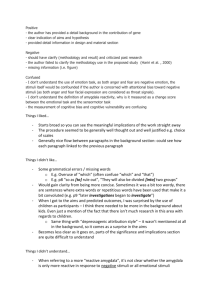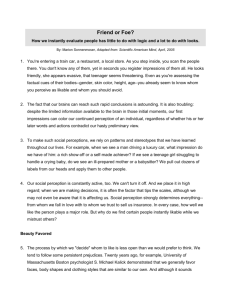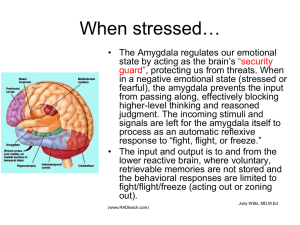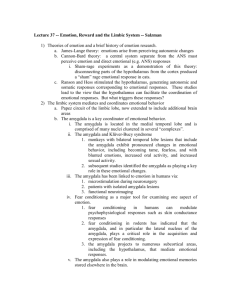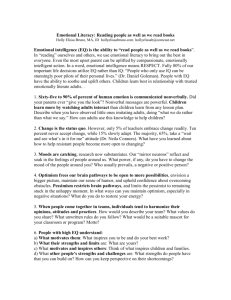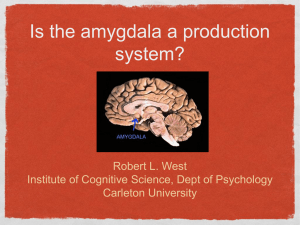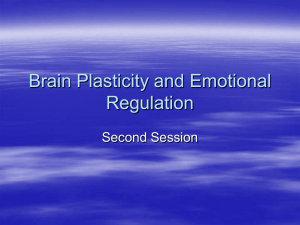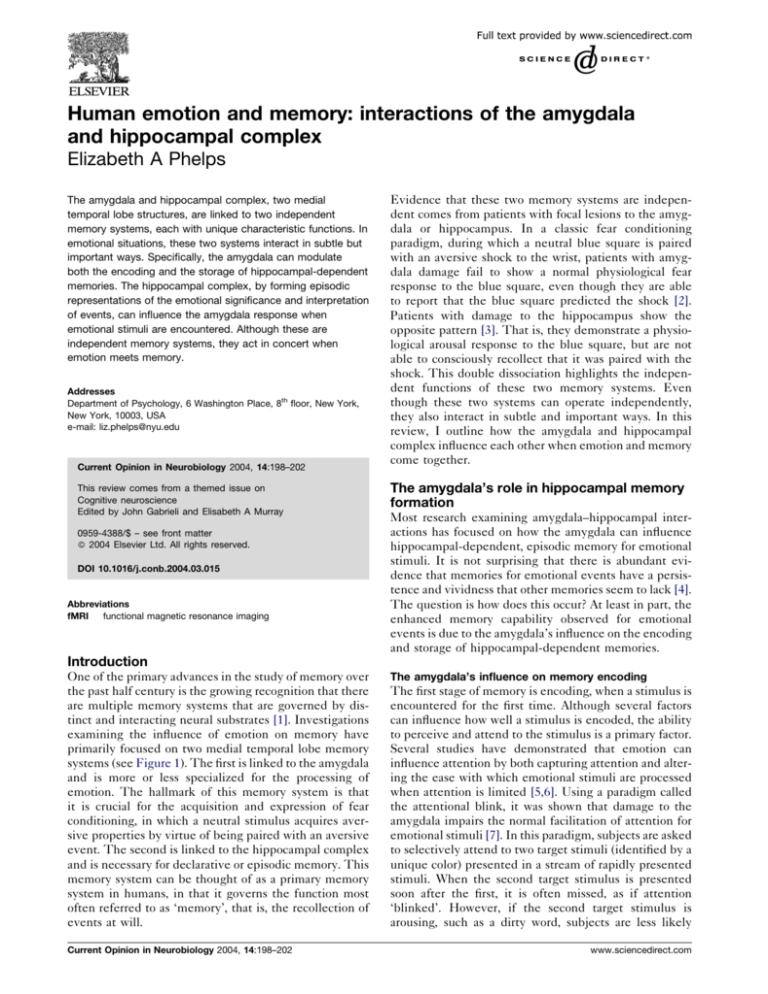
Human emotion and memory: interactions of the amygdala
and hippocampal complex
Elizabeth A Phelps
The amygdala and hippocampal complex, two medial
temporal lobe structures, are linked to two independent
memory systems, each with unique characteristic functions. In
emotional situations, these two systems interact in subtle but
important ways. Specifically, the amygdala can modulate
both the encoding and the storage of hippocampal-dependent
memories. The hippocampal complex, by forming episodic
representations of the emotional significance and interpretation
of events, can influence the amygdala response when
emotional stimuli are encountered. Although these are
independent memory systems, they act in concert when
emotion meets memory.
Addresses
Department of Psychology, 6 Washington Place, 8th floor, New York,
New York, 10003, USA
e-mail: liz.phelps@nyu.edu
Current Opinion in Neurobiology 2004, 14:198–202
This review comes from a themed issue on
Cognitive neuroscience
Edited by John Gabrieli and Elisabeth A Murray
0959-4388/$ – see front matter
ß 2004 Elsevier Ltd. All rights reserved.
DOI 10.1016/j.conb.2004.03.015
Abbreviations
fMRI
functional magnetic resonance imaging
Evidence that these two memory systems are independent comes from patients with focal lesions to the amygdala or hippocampus. In a classic fear conditioning
paradigm, during which a neutral blue square is paired
with an aversive shock to the wrist, patients with amygdala damage fail to show a normal physiological fear
response to the blue square, even though they are able
to report that the blue square predicted the shock [2].
Patients with damage to the hippocampus show the
opposite pattern [3]. That is, they demonstrate a physiological arousal response to the blue square, but are not
able to consciously recollect that it was paired with the
shock. This double dissociation highlights the independent functions of these two memory systems. Even
though these two systems can operate independently,
they also interact in subtle and important ways. In this
review, I outline how the amygdala and hippocampal
complex influence each other when emotion and memory
come together.
The amygdala’s role in hippocampal memory
formation
Most research examining amygdala–hippocampal interactions has focused on how the amygdala can influence
hippocampal-dependent, episodic memory for emotional
stimuli. It is not surprising that there is abundant evidence that memories for emotional events have a persistence and vividness that other memories seem to lack [4].
The question is how does this occur? At least in part, the
enhanced memory capability observed for emotional
events is due to the amygdala’s influence on the encoding
and storage of hippocampal-dependent memories.
Introduction
One of the primary advances in the study of memory over
the past half century is the growing recognition that there
are multiple memory systems that are governed by distinct and interacting neural substrates [1]. Investigations
examining the influence of emotion on memory have
primarily focused on two medial temporal lobe memory
systems (see Figure 1). The first is linked to the amygdala
and is more or less specialized for the processing of
emotion. The hallmark of this memory system is that
it is crucial for the acquisition and expression of fear
conditioning, in which a neutral stimulus acquires aversive properties by virtue of being paired with an aversive
event. The second is linked to the hippocampal complex
and is necessary for declarative or episodic memory. This
memory system can be thought of as a primary memory
system in humans, in that it governs the function most
often referred to as ‘memory’, that is, the recollection of
events at will.
Current Opinion in Neurobiology 2004, 14:198–202
The amygdala’s influence on memory encoding
The first stage of memory is encoding, when a stimulus is
encountered for the first time. Although several factors
can influence how well a stimulus is encoded, the ability
to perceive and attend to the stimulus is a primary factor.
Several studies have demonstrated that emotion can
influence attention by both capturing attention and altering the ease with which emotional stimuli are processed
when attention is limited [5,6]. Using a paradigm called
the attentional blink, it was shown that damage to the
amygdala impairs the normal facilitation of attention for
emotional stimuli [7]. In this paradigm, subjects are asked
to selectively attend to two target stimuli (identified by a
unique color) presented in a stream of rapidly presented
stimuli. When the second target stimulus is presented
soon after the first, it is often missed, as if attention
‘blinked’. However, if the second target stimulus is
arousing, such as a dirty word, subjects are less likely
www.sciencedirect.com
Human emotion and memory Phelps 199
Figure 1
The human amygdala (in blue) and hippocampus (in green).
to miss it. Put another way, this attentional limitation is
attenuated with emotion. Amygdala damage impairs the
normal attenuation of the attentional blink effect, which
suggests that the amygdala plays a crucial part in the
facilitation of attention with emotion.
The mechanism underlying the amygdala’s influence on
attention has been explored recently using functional
magnetic resonance imaging (fMRI). The amygdala has
reciprocal connections with sensory cortical processing
regions, such as the visual cortex [8]. It has been shown
that there is an enhanced response in the amygdala to
emotional stimuli (i.e. fearful faces) and this response is
correlated with a similar response in the visual cortex [8].
The amygdala responds to an emotional stimulus in the
environment rapidly [9], before awareness [10] and,
generally, irrespective of attentional focus [11,12,13].
It has been suggested that the amygdala might receive
information about the emotional significance of a stimulus
very early in stimulus processing and through feedback
connections could enhance later perception, resulting in
enhanced perceptual encoding for emotional events. This
enhanced perception might underlie emotion’s facilitation of attention and the overall increased vigilance
observed in the presence of emotional stimuli [14]. By
influencing perception and attention, the amygdala can
alter the encoding of hippocampal-dependent, episodic
memory, such that emotional events receive priority.
which these memories are somewhat fragile and prone to
disruption. It takes time for these memories to become
more or less ‘set’, at which point their retrieval is less
dependent on the hippocampus. This process is called
consolidation. It has been suggested that one reason for
this slow consolidation process is to allow an emotional
reaction to an event an opportunity to influence the
storage of that event. The emotional reaction, such as
arousal and the release of stress hormones, necessarily
follows the event itself [15]. In this way, events that elicit
emotional responses, which are likely to be more important for survival, are also more likely to be remembered
later. Animal models have suggested that the amygdala
modulates the consolidation of hippocampal-dependent
memories through the actions of stress hormones. In
short, stress hormones activate adrenergic receptors in
the basolateral amygdala, which modulates the effect of
these hormones on hippocampal consolidation [16]. In
support of these animal models, it has been shown in
humans that administering a b-adrenergic blocker eliminates emotion’s enhancement of episodic memory [17],
as does damage to the amygdala [18,19].
Further support for amygdala involvement in the
enhanced long-term memory for emotional events comes
from brain imaging studies. Several studies have shown a
correlation between activity in the amygdala at encoding
and later memory for emotional stimuli (see Figure 2;
[20–22]). Although these studies cannot rule out the
possibility that the observed memory enhancement is
due to the amygdala’s influence on attentional or perceptual systems, such as visual cortex, more recent studies
have shown a correlation between the amygdala’s
response to a stimulus and the responses in the parahippocampus, which is part of the hippocampal complex just
inferior to the hippocampus proper [23]. In addition, a
recent study by Dolan and co-workers [24] examined
Figure 2
The amygdala’s modulation of consolidation
The second stage of hippocampal memory formation is
retention or storage. There is also evidence that the
amygdala can influence the storage of memory. Hippocampal-dependent memories are not stored in an all or
none fashion. After encoding, there is a period of time in
www.sciencedirect.com
Activation of the amygdala predicts later memory. Amygdala activity
during encoding correlated with subsequent memory for (a) positive
and (b) negative arousing picture stimuli. Adapted from Hamann et al.
[22].
Current Opinion in Neurobiology 2004, 14:198–202
200 Cognitive neuroscience
patients with varying degrees of pathology to the hippocampus and amygdala during the encoding of emotional
and neutral words. Using fMRI, they found that greater
left amygdala pathology predicted both worse subsequent
memory for the emotional words and less activity in the
left hippocampus. Memory for neutral words was only
related to the degree of hippocampal pathology. Interestingly, the relationship between the pathology of the
amygdala and hippocampus and the activity in response
to emotion words was bi-directional. More left hippocampal pathology predicted less activity in the left amygdala
and more activity in the right amygdala, which suggests a
mutual dependence of the hippocampus and amygdala
when remembering emotional stimuli.
The brain imaging and patient studies cited above support a role for the human amygdala in modulating the
hippocampal complex, but do not indicate that this modulation alters the consolidation or storage of memory per
se. This question was addressed in two recent studies by
Cahill and co-workers. Using a pharmacological [25] and
pain [26] manipulation that elicited a stress hormone
response immediately after a target stimulus was
encoded, they were able to demonstrate enhanced memory for this stimulus. These results strongly support the
conclusion that emotion can alter the retention of emotional events and are consistent with the animal models
suggesting a role for the amygdala in the modulation of
hippocampal consolidation.
An emerging topic in our efforts to understand the
mechanisms underlying the amygdala’s influence on
emotional memory is the unique roles of the left and
right amygdala. Recent brain imaging studies have suggested that the left and right amygdala could be differentially involved in memory for emotional stimuli
depending on the sex of the subject. Specifically, two
recent studies have shown that the left amygdala is
correlated with later memory for emotional stimuli in
female subjects, whereas the right amygdala is correlated
with memory for emotional stimuli in male subjects
[27,28]. It is unclear if this laterality difference could
be related to sex differences in stimulus processing strategies or other factors. However, studies examining emotional memory or physiological responses to emotional
stimuli in patients with amygdala damage have failed to
find such sex differences. These studies have tended to
be consistent with previous studies on hippocampal function showing a material specific involvement of the left
and right amygdala for verbal and visual material, respectively [19,29,30]. It is unclear at this time how data from
these two different techniques will inform our understanding of the specific roles of the left and right amygdala
in episodic memory for emotional events.
In addition to its primary role in the acquisition and
physiological expression of conditioned fears, the amygCurrent Opinion in Neurobiology 2004, 14:198–202
dala has a secondary role influencing the encoding and
storage of hippocampal-dependent, episodic memories.
This role is modulatory, in that the amygdala is not
necessary for forming episodic memories of emotional
or neutral events. Rather, the amygdala enhances hippocampal-dependent memory with emotion.
The influence of hippocampal-dependent
memory on amygdala function
Although most of the research examining amygdala–
hippocampal interactions has explored how the amygdala
can influence episodic memory, there is also evidence of
episodic memory influencing the amygdala. In the typical
fear conditioning paradigm, a subject learns that a neutral
stimulus predicts an aversive event by virtue of their
pairing. In everyday human experience this type of
learning often occurs. For example, if you were bitten
by a neighborhood dog, the next time you encounter this
dog you might have a fear response. This is an everyday
example of fear conditioning. However, for humans it is
also possible to learn about the emotional significance of
stimuli in the environment through other means, such as
verbal communication. You might have a similar fear
response to the neighborhood dog if your neighbor had
previously told that it was a dangerous dog that might bite
you. This type of learning through instruction requires
the hippocampal complex for acquisition and, possibly,
for retrieval when the fearful stimulus is present.
Through instruction, subjects can acquire an episodic
representation of the emotional significance of an event
without any direct aversive experience. The question is,
does this hippocampal-dependent, episodic representation of emotional significance influence the amygdala?
In an fMRI study, subjects were told that they would
receive one or more mild shocks to the wrist, but only
when a blue square was presented. Although no shocks
were actually presented, subjects showed an arousal
response during presentation of the blue square as well
as activation of the left amygdala (see Figure 3; [31]). A
similar study found that damage to the left amygdala
impaired the physiological fear response to the blue square
[29]. These results suggest that having an instructed,
episodic representation of the emotional significance of
a stimulus can lead to activation of the amygdala, which in
turn mediates the physiological expression of fear when
this stimulus is encountered. These types of fears are
imagined and anticipated, but never actually experienced,
yet they rely on similar neural mechanisms for expression
as those that are learned through direct experience.
Another example of hippocampal-dependent, episodic
representations influencing amygdala function comes
from recent studies on emotion regulation [32,33].
Our ability to regulate our emotional responses is an
important part of normal social behavior. Studies examining the neural systems of emotion regulation instruct
www.sciencedirect.com
Human emotion and memory Phelps 201
Figure 3
(a)
(b)
Current Opinion in Neurobiology
Amygdala activation to an episodic representation of fear. Left amygdala activation to instructed fear. Composite activation response to (a) threat
versus safe stimuli and (b) selected individual subjects. Adapted from Phelps et al. [31].
subjects to use strategies to alter their response to emotional stimuli. A recent fMRI study instructed subjects to
‘reappraise’ the emotional significance of a negative scene
by trying to interpret the events depicted in a nonemotional or positive light [32]. Both the acquisition
and the appropriate application of this strategy require
hippocampal-dependent memory. The reappraisal strategy was successful in diminishing both the reported
emotional reaction to the negative scenes and the amygdala response.
The recollection of emotional stimulus properties and
strategies acquired through instruction requires the formation of hippocampal-dependent memories. These episodic memories can influence our emotional reactions, at
least in part by modulating the amygdala.
Conclusions
The amygdala and hippocampal complex govern two
independent memory systems that interact when emotion
meets memory. We are just beginning to understand the
subtleties of these interactions in humans and there are
still several unanswered questions.
Although we know more about the mechanisms that
underlie the amygdala’s influence on hippocampaldependent episodic memory, it is not clear how the
modulation of attention and encoding complements the
modulation of consolidation. It has been suggested that
the amygdala primarily enhances episodic memory for the
gist of an emotional event at the expense of details [34],
which may be related to attention. It has also been
suggested that this gist versus peripheral detail memory
enhancement might interact with sex and laterality when
memories are consolidated [35]. Researchers are only
beginning to investigate these topics and it is unclear
which, if any, of these factors will prove to be important.
www.sciencedirect.com
In addition, a recent fMRI study suggested that the
relationship between the amygdala and the hippocampus
might be bi-directional during the encoding of emotional
events [24]. Exactly what role hippocampal feedback to
the amygdala might play in the enhancement of episodic
memory with emotion is not known.
It is clear that episodic memory plays a part in our
representation of emotion and this can influence the
amygdala [31]. However, very little is known about
exactly how an episodic representation alters amygdala
function. This is partially due to the fact that we have a
relatively poor understanding of the precise mechanisms
of storage for hippocampal-dependent memories in general, although it is likely that working memory plays an
important part when an episodic memory is retrieved. A
recent fMRI study on emotion regulation [32] suggested that areas typically linked to working memory
are involved when instructed strategies are applied and
the amygdala response is modulated.
Until recently, emotion was not typically considered in
our efforts to understand cognitive behaviors, such as
memory. However, it has become increasingly clear that
we can no longer neglect the exploration of emotion, as it
is rarely absent from our daily functions. In this review,
we have highlighted what has been learned from investigations into the neural systems of emotion and memory
in humans thus far, which has often relied on animal
models as a guide. We are just starting to explore more
complex interactions between emotion and memory that
could be unique to human function.
Acknowledgements
The author would like to acknowledge K Nearing and B Sedgewick
for assistance with figure preparation and M Delgado for helpful
comments.
Current Opinion in Neurobiology 2004, 14:198–202
202 Cognitive neuroscience
References and recommended reading
Papers of particular interest, published within the annual period of
review, have been highlighted as:
of special interest
of outstanding interest
1.
2.
3.
Squire LR, Knowlton BJ: The medial temporal lobe, the
hippocampus, and memory systems of the brain. In The New
Cognitive Neurosciences, edn 2. Edited by Gazzaniga MS.
Cambridge, Massachusetts: MIT Press; 2000:765-780.
LaBar KS, LeDoux JE, Spencer DD, Phelps EA: Impaired fear
conditioning following unilateral temporal lobectomy in
humans. J Neurosci 1995, 15:6846-6855.
Bechara A, Tranel D, Damasio H, Adolphs R, Rockland C,
Damasio AR: Double dissociation of conditioning and
declarative knowledge relative to the amygdala and
hippocampus in humans. Science 1995, 269:1115-1118.
4.
Christianson SA: The handbook of emotion and memory:
research and theory. Hillsdale NJ: Lawrence Erlbaum Associates;
1992.
5.
Fox E, Russo R, Bowles R, Dotton K: Do threatening stimuli draw
or hold attention in visual attention in subclinical anxiety.
J Exp Psych Gen 2001, 130:681-700.
6.
Ohman A, Flykt A, Esteves F: Emotion drives attention: detecting
the snake in the grass. J Exp Psych Gen 2001, 130:466-478.
7.
Anderson AK, Phelps EA: The human amygdala supports
affective modulatory influences on visual awareness.
Nature 2001, 411:305-309.
8.
Amaral DG, Behniea H, Kelly JL: Topographic organization of
projections from the amygdala to the visual cortex in the
macaque monkey. Neuroscience 2003, 118:1099-1120.
9. LeDoux JE: The synaptic self. New York:
Viking Press; 2002.
This book reviews what is known about amygdala function and how this
might be related to the perception of self.
10. Whalen PJ, Rauch SL, Etcoff NL, Mcinerney SC, Lee MB,
Jenike MA: Masked presentations of emotional facial
expressions modulate amygdala activity without explicit
knowledge. J Neurosci 1998, 18:411-418.
19. LaBar KS, Phelps EA: Role of the human amygdala in
arousal mediated memory consolidation. Psych Sci 1998,
9:490-493.
20. Cahill L, Haier RJ, Fallon J, Alkire MT, Tang C, Keator D, Wu J,
McGaugh JL: Amygdala activity at encoding correlated with
long-term, free recall of emotional information. Proc Natl Acad
Sci U S A 1996, 93:8016-8021.
21. Canli T, Zhao Z, Brewer J, Gabrieli JD, Cahill L: Event-related
activation of the human amygdala associates with later
memory for individual emotional experience.
J Neurosci 2000, 20:RC99.
22. Hamann SB, Ely TD, Grafton DT, Kilts CD: Amygdala activity
related to enhanced memory for pleasant and aversive stimuli.
Nat Neurosci 1999, 2:289-293.
23. Kirkpatrick L, Cahill L: Amygdala modulation of
parahippocampal and frontal regions during emotionally
influenced memory storage. Neuroimage 2003, 20:2091-2099.
24. Richardson MP, Strange B, Dolan RJ: Encoding of emotional
memories depends on the amygdala and hippocampus and
their interactions. Nat Neurosci 2004, 7:278-285.
This is an intriguing study that explores changes in the hippocampal
response during emotional encoding with amygdala damage and vice
versa.
25. Cahill L, Alkire MT: Epinephrine enhancement of human memory
consolidation: interaction with arousal at encoding.
Neurobiol Learn Mem 2003, 79:194-198.
This study demonstrates how a stress hormone response that occurs
after learning can influence later memory for arousing stimuli.
26. Cahill L, Gorski L, Le K: Enhanced human memory consolidation
with post-learning stress: interaction with degree of arousal at
encoding. Learn Mem 2003, 10:270-274.
27. Cahill I, Haier RJ, White NS, Fallon J, Kilpatrick L, Lawrence C,
Potkin SG, Alkire MT: Sex-related difference in amygdala
activity during emotionally influenced memory storage.
Neurobiol Learn Mem 2001, 75:1-9.
28. Canli T, Desmond JE, Zhao Z, Gabrieli JD: Sex differences in the
neural basis of emotional memories. Proc Natl Acad Sci U S A
2002, 99:10789-10794.
This study explores the complex relation among sex, emotion, memory
and laterality of amygdala involvement.
11. Vuilliemuer P, Schwartz S: Beware and be aware: capture of
spatial attention by fear-related stimuli in neglect.
Neuroreport 2001, 12:1119-1122.
29. Funayama ES, Grillon CG, Davis M, Phelps EA: A double
dissociation in the affective modulation of startle in humans:
effects of unilateral temporal lobectomy. J Cogn Neurosci 2001,
13:721-729.
12. Anderson AK, Christoff K, Panitz D, DeRosa E, Gabrieli J:
Neural correlates of the automatic processing of threat facial
signals. J Neurosci 2003, 23:5627-5633.
This study explores the complex interaction between amygdala response
to fearful and disgusting faces and attentional focus.
30. Adolphs R, Tranel D, Denberg N: Impaired emotional declarative
memory following unilateral amygdala damage. Learn Mem
2000, 7:180-186.
13. Vuilleumier P, Armony JL, Driver J, Dolan RJ: Effects of attention
and emotion and face processing in the human brain: an event
related fMRI study. Neuron 2001, 30:829-841.
14. Davis M, Whalen PJ: The amygdala: vigilance and emotion.
Mol Psychiatry 2001, 6:13-34.
15. McGaugh JL: Memory – a century of consolidation.
Science 2000, 287:248-251.
16. McGaugh JL, Roozendaal B: Role of adrenal stress hormones
in the forming of lasting memories in the brain. Curr Opin
Neurobiol 2002, 12:205-210.
This is a comprehensive review of the research with nonhuman animals
demonstrating a role for the amygdala in the modulation of hippocampal
consolidation.
17. Cahill L, Prins B, Weber M, McGaugh JL: b-adrenergic activation
and memory for emotional events. Nature 1994, 371:702-704.
18. Cahill L, Babinsky R, Markowitsch HJ, McGaugh JL: The amygdala
and emotional memory. Science 1995, 377:295-296.
Current Opinion in Neurobiology 2004, 14:198–202
31. Phelps EA, O’Connor KJ, Gatenby JC, Grillon C, Gore JC, Davis M:
Activation of the left amygdala to a cognitive representation of
fear. Nat Neurosci 2001, 4:437-441.
32. Oschner KN, Bunge SA, Gross JJ, Gabrieli JDE: Rethinking
feelings: an fMRI study of the cognitive regulation of emotion.
J Cogn Neurosci 2002, 14:1215-1229.
This study examines the neural substrates underlying our ability to
regulate our emotional responses and demonstrates that the amygdala
response might be altered by cognitive strategies.
33. Schaefer SM, Jackson DC, Davidson RJ, Kimberg DY,
Thompson-Schill SL: Modulation of amygdalar activity by the
conscious regulation of negative emotion. J Cogn Neurosci
2002, 14:913-921.
34. Adolphs R, Denberg NL, Tranel D: The amygdala’s role in
long-term declarative memory for gist and detail.
Behav Neurosci 2001, 115:983-992.
35. Cahill L, van Stegeren A: Sex-related impairment of memory
for emotional events with beta-adrenergic blockade.
Neurobiol Learn Mem 2003, 79:81-88.
www.sciencedirect.com

